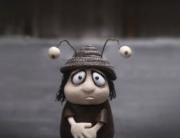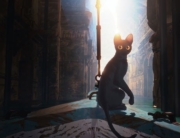The arresting fiction of Haruki Murakami—populated by hallucinatory episodes that rub up against reality, enigmatic relationships, and malleable memories of his assiduously oddish characters—has gotten a boost from recent film adaptations of his novels and short stories, including Norwegian Wood, Burning, and last year’s best international film Oscar winner, Drive My Car.
But the magic realism that permeates Murakami’s haunting tales—the presence of ghostly figures, anthropomorphic animals, and natural disasters, all making their indelible marks on everyday existence—seem best suited to animation, which can conjure fantastical worlds more seamlessly than live-action.
Blind Willow, Sleeping Woman, the debut feature by French composer-animator Pierre Földes, initially tantalizes in its visualization of the very particular Murakami universe. The striking animation alternates between offhand sketches, ingenious 3D computer techniques, and the tracing of actors, reminiscent of the rotoscoping in Richard Linklater’s A Scanner Darkly. The characters move through realistic settings that are also slightly surreal, with a ghostly or supernatural glimmer about them (secondary characters are at times literally transparent).
Yet the initial excitement wanes. Földes has adapted six self-contained Murakami short stories (including the eponymous tale), but has gratuitously linked them together. Although the author includes his favorite motifs, themes, and subjects that recur in his tales (spaghetti, jazz, the Beatles, and cats, for starters), each story has its own satisfying inner logic. The film, however, strains to fit its characters and their circumstances into an overarching structure that’s tenuously connected. (Murakami’s stories are often about missed connections of a physical, emotional, or spiritual sort.)
The film’s narrative backbone is the 2011 earthquake and tsunami that devastated eastern Japan. Kyoko (voiced by Shoshana Wilder), the wife of Komura (Ryan Bommarito), an employee at a local bank, is glued to the TV coverage—until she leaves a note saying she is going to live with her parents and not come back. This leads Komura to ask for a week off work, which he uses to take a vacation and also deliver a curious package to a colleague’s sister.
Another of Komura’s bank colleagues, the meek and dutiful Katagiri (Marcelo Arroyo), is visited at home by a tall, anthropomorphic frog (Földes)—named Frog—who tells him his dire financial situation at work will be fixed if he helps Frog battle a huge underground worm—named Worm—about to devastate Tokyo with an earthquake. Increasingly strange events occur, but the effortless shifting among past and present, reality, and dreams at which Murakami excels comes off as irritatingly arbitrary on film.
To his credit, Földes is a skillful animator. Pithy images, like the commuter train carrying a weary Katagiri to work morphing into the enormous worm that Frog has warned him about, are frequent. Then there’s Földes’s own inventive score, pitched somewhere between jazz and classical, which aptly complements the savory visuals, along with the well-chosen Mozart piano works.
For all its faults, Blind Willow, Sleeping Woman does catch the unique flavor of Haruki Murakami’s fiction in its stylistic variety, idiosyncratic characterization, and thoughtful observations. If the film ends up pointing its viewers toward the masterly stories it’s based on, then that might be sufficient.







Leave A Comment